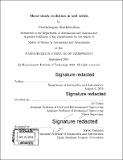| dc.contributor.advisor | Tal Cohen. | en_US |
| dc.contributor.author | Senthilnathan, Chockalingam. | en_US |
| dc.contributor.other | Massachusetts Institute of Technology. Department of Aeronautics and Astronautics. | en_US |
| dc.date.accessioned | 2020-10-18T21:26:57Z | |
| dc.date.available | 2020-10-18T21:26:57Z | |
| dc.date.copyright | 2019 | en_US |
| dc.date.issued | 2019 | en_US |
| dc.identifier.uri | https://hdl.handle.net/1721.1/128058 | |
| dc.description | Thesis: S.M., Massachusetts Institute of Technology, Department of Aeronautics and Astronautics, 2019 | en_US |
| dc.description | Cataloged from PDF of thesis. | en_US |
| dc.description | Includes bibliographical references (pages 83-85). | en_US |
| dc.description.abstract | Nonlinear evolution of shear waves into shocks in incompressible elastic materials is investigated using the framework of large deformation elastodynamics, for a family of loadings and commonly used hyperelastic material models. Closed form expressions for the shock formation distance are derived and used to construct non-dimensional phase maps that determine regimes in which a shock can be realized. These maps reveal the sensitivity of shock evolution to the amplitude, shape, and ramp time of the loading, and to the elastic material parameters. In light of a recent study (Espindola et al., 2017), which hypothesizes that shear shock formation could play a significant role in Traumatic Brain Injury (TBI), application to brain tissue is considered and it is shown that the size matters in TBI research. Namely, for realistic loadings, smaller brains are less susceptible to formation of shear shocks. Furthermore, given the observed sensitivity to the imparted waveform and the constitutive properties, it is suggested that the non-dimensional maps can guide the design of protective structures by determining the combination of loading parameters, material dimensions, and elastic properties that can avoid shock formation. | en_US |
| dc.description.statementofresponsibility | by Chockalingam Senthilnathan. | en_US |
| dc.format.extent | 85 pages | en_US |
| dc.language.iso | eng | en_US |
| dc.publisher | Massachusetts Institute of Technology | en_US |
| dc.rights | MIT theses may be protected by copyright. Please reuse MIT thesis content according to the MIT Libraries Permissions Policy, which is available through the URL provided. | en_US |
| dc.rights.uri | http://dspace.mit.edu/handle/1721.1/7582 | en_US |
| dc.subject | Aeronautics and Astronautics. | en_US |
| dc.title | Shear shock evolution in soft solids | en_US |
| dc.type | Thesis | en_US |
| dc.description.degree | S.M. | en_US |
| dc.contributor.department | Massachusetts Institute of Technology. Department of Aeronautics and Astronautics | en_US |
| dc.identifier.oclc | 1199060323 | en_US |
| dc.description.collection | S.M. Massachusetts Institute of Technology, Department of Aeronautics and Astronautics | en_US |
| dspace.imported | 2020-10-18T21:26:54Z | en_US |
| mit.thesis.degree | Master | en_US |
| mit.thesis.department | Aero | en_US |
